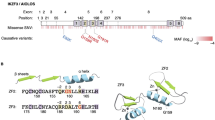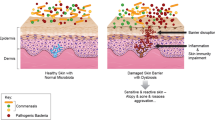Abstract
A newH-2 mutant, BALB/c-H-2 db, is described. This mutant originated in BALB/c, is inbred, and is coisogenic with the parental BALB/cKh strain. The mutation is of the loss type since BALB/c-H- db rejects BALB/c, but not vice versa. Complementation studies have localized the mutation to theD region of theH-2 complex. A cross between BALB/c-H-2 db and B10.D2-H-2 da failed to complement for either BALB/c or B10.D2 skin grafts, indicating that these are two separate mutations at the same locus (Z2). Direct serological analysis and absorption studies revealed that, with one exception, theH-2 andIa specificities of BALB/c and BALB/c-H-2 db are identical. In particular,H-2.4, the H-2Dd private specificity, is quantitatively and qualitatively identical in the two strains. The exception is that of the specificities detected by antiserum D28b: (k×r)F1 anti-h, which contains anti-H-2.27, 28, and 29. These specificities appear to be absent from theH-2 db mutant since they are not detected directly or by absorption. Other public specificities are present in normal amounts,e.g., the reaction with antisera to H-2.3, 8, 13, 35, and 36. The reaction with antiserum D28 (f×k)F1 anti-s, which contains antibodies to H-2.28, 36, and 42, is the same in both strains. Antiserum made between the two strains (H-2 db anti-H-2 d) reacts like an anti-H-2 serum, in that it reacts with both T and B cells by cytotoxicity, but is not a hemagglutinating antibody. The serum reacts as does the D28b serum in both strain distribution and in cross-absorption studies. We conclude that theH-2 db mutation occurred at a locus in theD region, resulting in the loss of the H-2.28 public serological specificity and of a histocompatibility antigen. Whether these are one and the same antigen is not yet known. The data, in view of other evidence, imply that the public and private specificities are coded for by separate genes.
Similar content being viewed by others
Abbreviations
- CML:
-
cell-mediated lysis
- MLR:
-
mixed lymphocyte reaction
- GVHR:
-
graft-versus-host reaction
- RFC:
-
rosette-forming cells
- RAM-Ig:
-
rabbit anti-mouse IgG
References
Apt, A.S., Blandova, Z., Dishkant, I., Shumova, T., Vedernikov, A.A., and Egorov, I.K.: Study ofH-2 mutations in mice. IV. A comparison of the mutants M 505 and HZ1 by skin grafting and serological techniques.Immunogenetics 1:444–451, 1975
Bailey, D.W., Snell, G.D., and Cherry, M.: Complementation and serological analysis of anH-2 mutant.In A. Lengerova and M. Vojtiskova (eds.):Immunogenetics of the H-2 System. pp. 152–162, Karger, Basel, 1971
Blandova, Z., Mnatsakanyan, Y.A., and Egorov, I.K.: Study of H-2 mutations in mice. VI. M 523, a newK-end mutant.Immunogenetics 2:291–295, 1975
Cullen, S.E., and Nathenson, S.G.: Distribution of H-2 alloantigenic specificities on radiolabelled papain solubilized antigen fragments.J. Immunol. 107:563–570, 1971
Démant, P., Snell, G.D., Hess, M., Lemonnier, F., Neauport-Sautes, C., and Kourilsky, F.: Separate and polymorphic genes controlling two types of polypeptide chains bearing theH-2 private and public specificities.J. Immunogenetics 2:263–271, 1975
Dishkant, I.P., Vedernikov, A.A., and Egorov, I.K.: Study ofH-2 mutations in mice. III. Serological analysis of the mutation 504 and its derived recombinantH-2 haplotypes.Genetika (Moscow) 9:82–87, 1973
Dux, A., Corduwener, D., and Muhlbock, O.: Analysis of the difference of theH-2 locus between the C57BL/LiA and the C57BL/10 ScSn strains.In A. Lengerova and M. Vojtiskova (eds.):Immunogenetics of the H-2 System, pp. 163–165, Karger, Basel, 1971
Egorov, I.K.: A mutation of the histocompatibility-2 locus in the mouse.Genetika (Moscow) 9:136–144, 1967
Egorov, I.K.: Genetic control of H-2 alloantigens as inferred from analysis of mutations.Immunogenetics 1:97–107, 1974
Klein, J.:Biology of the Mouse Histocompatibility-2 Complex. pp. 124–125, Springer-Verlag, New York, 1975
Kohn, H.I.:H-gene (histocompatibility) mutation induced by triethylenelamine in the mouse.Mutat Res. 20:235–242, 1973
Lemonnier, F., Neauport-Sautes, C., Kourilsky, F.M., and Démant, P.: Relationships between private and public H-2 specificities on the cell surface.Immunogenetics 2:517–129, 1975
McKenzie, I.F.C., and Henning, M.M.: A histocompatibility region (H-21C) in theIC region of theH-2 complex of the mouse.Immunogenetics 3:253–260, 1976
McKenzie, I.F.C., and Snell, G.D.: Comparative immunogenicity and enhanceability of individualH-2K andH-2D specificities of the murine histocompatibility-2 complex.J. Exp. Med. 138:250–277, 1973
McKenzie, I.F.C., Morgan, G.M., Melvold, R.W., and Kohn, H.I.: Serological and complementation studies in fourH-2 b mutants.Immunogenetics 3:241–251 1976
Melief, C.J.M., Schwartz, R.S., Kohn, H.I., and Melvold, R.W.: Dermal histocompatibility and in vitro lymphocyte reactions of three newH-2 mutants.Immunogenetics 2:337–348, 1975
Melief, C.J.M., Schwartz, R.S., Kohn, H.I., Melvold, R.W., and Dux, A.: Analysis ofH-2 mutants. Cell-mediated reactivity of theH-2be variant and fourZ1 locus mutants. in press, 1976
Melvold, R.W., and Kohn, H.I.: Eight new histocompatibility mutations associated with theH-2 complex.Immunogenetics 3:185–191, 1976
Parish, C.R.: Preferential induction of cell mediated immunity by chemically modified sheep erythrocytes.Eur. J. Immunol. 2:143–146, 1972
Parish, C.R., Kirov, S.M., Bowern, N., and Blanden, R.V.: A one-step procedure for separating mouse T and B lymphocytes.Eur. J. Immunol. 4:808–815, 1974
Shreffler, D.C., and David, C.S.: TheH-2 major histocompatibility complex and theI immune response region. Genetic variation, function and organization.Adv. Immunol. 20:125–195, 1975
Shumova, T.E., Kryshkina, V.P., and Egorov, I.K.: Study ofH-2 mutations in mice. I. Analysis of the mutation M 504 by the F1 hybrid method.Genetika (Moscow) 8:171–173, 1972
Snell, G.D., Démant, P., and Cherry, M.: Hemagglutination and cytotoxic studies ofH-2: the anti-27, 28, 29 family of antibodies.Folia Biol. (Praha) 20:145–160, 1974
Stimpfling, J.H., and Pizzaro, O.: On the antigenic products of theH-2 m allele in the laboratory mouse.Transplant. Bull. 28:102–106, 1961
Author information
Authors and Affiliations
Rights and permissions
About this article
Cite this article
McKenzie, I.F.C., Morgan, G.M., Melvold, R.W. et al. BALB/c-H-2 db: A newH-2 mutant in BALB/cKh that identifies a locus associated with theD region. Immunogenetics 4, 333–347 (1977). https://doi.org/10.1007/BF01575672
Received:
Issue Date:
DOI: https://doi.org/10.1007/BF01575672




